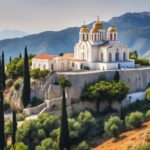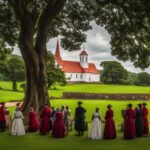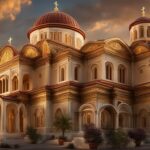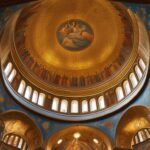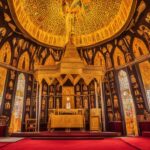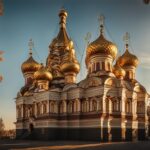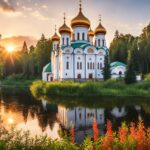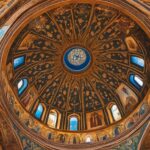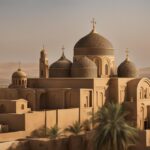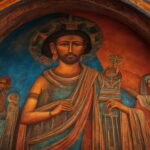The Moravian Church, also known as the Unity of Brethren, has a fascinating history that dates back centuries. From its origins in ancient Bohemia and Moravia to its global influence today, the Moravian Church holds a significant place in the history of Christianity.
The Moravian Church was officially organized in 1457, making it one of the oldest Protestant denominations in the world. Its origins can be traced back to the influence of Greek Orthodox missionaries Cyril and Methodius, who translated the Bible into the common language and introduced a national church ritual. The church was further shaped by the Czech reformer John Hus, who protested against the practices of the Roman Catholic clergy and hierarchy.
Despite facing persecution and schisms throughout its history, the Moravian Church has persevered and thrived. The church’s key beliefs and doctrines are rooted in living a life guided by the teachings of Jesus Christ, prioritizing unity, love for enemies, gentleness, humility, and patience.
The Moravian Church has played a significant role in history. It was known as the first Protestant missionaries and sent the first group of missionaries to the West Indies in 1732. The church also contributed to the development of education and culture in the areas where it was established.
Throughout the centuries, the Moravian Church has experienced schisms and denominational splits. Notable splits occurred during the Thirty Years War in the 1600s and during the leadership of Count Nicholas Ludwig von Zinzendorf in the 18th century.
The leadership and governance of the Moravian Church are unique. The church is led by bishops, who are elected by the Unity Synod every seven years. Local congregations are led by pastors, emphasizing the importance of community and collaboration in decision-making processes.
Worship practices in the Moravian Church include the lovefeast, a ceremonial meal that fosters communal worship and fellowship. Hymn singing is also integral to Moravian worship, reflecting the church’s rich tradition of hymn composition and singing.
The Moravian Church’s contemporary influence is seen through its involvement in community service, education, and mission work. The church is committed to social justice and outreach to marginalized communities, maintaining strong ecumenical relations.
Currently, the Moravian Church has over one million members worldwide, with a significant presence in eastern Africa, the Caribbean basin, South Africa, and North America. In North America, the church has congregations in 16 states, the District of Columbia, and two provinces of Canada.
Key Takeaways:
- The Moravian Church, or Unity of Brethren, originated in ancient Bohemia and Moravia and is one of the oldest Protestant denominations.
- The church’s beliefs are rooted in living a life guided by the teachings of Jesus Christ, emphasizing unity, love for enemies, gentleness, humility, and patience.
- The Moravian Church has played a significant role in history as the first Protestant missionaries and contributors to education and culture.
- The church has experienced schisms and denominational splits, including during the Thirty Years War and under the leadership of Count Nicholas Ludwig von Zinzendorf.
- Leadership and governance in the Moravian Church involve bishops elected by the Unity Synod and a focus on community and collaboration.
Origins and Founders of the Moravian Church
The Moravian Church traces its origins back to two Greek Orthodox missionaries, Cyril and Methodius, who translated the Bible into the common language and introduced a national church ritual. These missionaries played a crucial role in spreading Christianity in ancient Bohemia and Moravia, which is now the Czech Republic. Their translation of the Bible made the teachings of Jesus Christ accessible to the people, contributing to the formation of a religious community rooted in their shared faith.
Another influential figure in the development of the Moravian Church is the Czech reformer John Hus. Hus was a strong advocate for church reform and criticized the practices of the Roman Catholic clergy and hierarchy. He called for the Bible to be available in the common language, emphasized the importance of personal faith, and urged people to question religious authority. Hus’s ideas resonated with many, and he became a symbol of resistance against corruption within the church.
Despite facing persecution, Hus’s followers, known as the Unity of Brethren or Moravians, gathered in the village of Kunvald in 1457 and officially organized the Moravian Church. Their commitment to translating the Bible, promoting church reform, and living according to the teachings of Jesus Christ laid the foundation for the Moravian Church, which has continued to thrive for centuries.
“The church was further shaped by the Czech reformer John Hus, who protested against the practices of the Roman Catholic clergy and hierarchy.”
Key Figures and their Role:
| Figure | Contribution |
|---|---|
| Cyril and Methodius | Translated the Bible into the common language and introduced a national church ritual. |
| John Hus | Advocated for church reform, criticized the practices of the Roman Catholic clergy and hierarchy, and emphasized the importance of personal faith. |
Key Beliefs and Doctrines of the Moravian Church
The Moravian Church, also known as the Unity of Brethren, is guided by a set of key beliefs and doctrines that shape its teachings and practices. Central to the Moravian faith is the belief in living a life that reflects the teachings of Jesus Christ. Moravians emphasize the importance of following Jesus’ example of love, humility, and selflessness in everyday life.
Unity is another core belief of the Moravian Church. Moravians strive to foster unity among believers, recognizing that they are part of a larger spiritual family. This emphasis on unity extends beyond their own church community, as Moravians seek to build relationships and collaborate with other Christian denominations.
A distinctive belief of the Moravian Church is the practice of loving one’s enemies. Moravians aim to embody this teaching of Jesus by extending forgiveness and compassion, even to those who may have wronged them. This belief in loving one’s enemies can be seen as an expression of the church’s commitment to peace, reconciliation, and the transforming power of Christ’s love.
The Teachings of Jesus Christ
The Moravian Church believes in living a life guided by the teachings of Jesus Christ.
Unity Among Believers
Moravians prioritize unity among believers and seek to build relationships with other Christian denominations.
Love for Enemies
Moravians emphasize the practice of loving one’s enemies, extending forgiveness and compassion even to those who may have wronged them.

Table: Comparison of Moravian Church Beliefs
| Beliefs | Moravian Church | Christianity |
|---|---|---|
| Guiding Principles | Teachings of Jesus Christ, love, humility, selflessness | Teachings of Jesus Christ, love, forgiveness, salvation |
| Unity | Emphasized, collaboration with other Christian denominations | Varies among denominations |
| Love for Enemies | Emphasized, extends forgiveness and compassion to enemies | Teaching of Jesus, but interpretation may vary |
Historical Significance of the Moravian Church
The Moravian Church holds immense historical significance, despite its relatively small size. This Protestant denomination has made a lasting impact on the global Christian community and beyond. One of the most notable contributions of the Moravian Church is its role as the first Protestant missionary organization. In 1732, the church sent its first group of missionaries to the West Indies. This marked the beginning of a long history of missionary work, with Moravian missionaries reaching every continent and establishing thriving communities.
Moreover, the Moravian Church played a significant part in the development of education and culture in the areas where it was established. The church’s commitment to learning led to the establishment of educational institutions, such as Salem Academy and College in North Carolina and Moravian College and Theological Seminary. These institutions have had a positive impact on countless individuals, providing them with quality education and shaping their intellectual growth.
| Historical Significance | Moravian Church Impact |
|---|---|
| First Protestant missionary organization | Established missionary communities worldwide |
| Contributed to education and culture | Established renowned educational institutions |
The Moravian Church’s historical significance goes beyond its missionary and educational endeavors. The church has also played a vital role in advocating for social justice and working towards the betterment of marginalized communities. With a strong commitment to serving others, the Moravian Church has been actively involved in community service, both domestically and internationally. This dedication to making a positive impact on society has exemplified the church’s influence over the years.
“The Moravian Church’s historical impact has been far-reaching. From its missionary efforts to its educational contributions and social justice advocacy, the church has left an indelible mark on the world. Through its unwavering commitment to faith, love, and service, the Moravian Church continues to make a significant difference in the lives of individuals and communities worldwide.” – Reverend Sarah Thompson, Moravian Church Historian
Denominational Split or Schisms in the Moravian Church
The Moravian Church, despite its long history and enduring faith, has experienced schisms and denominational splits throughout the centuries. These divisions have shaped the church’s trajectory, leading to the establishment of new branches and the preservation of distinctive traditions.
Denominational Split during the Thirty Years War
One significant schism occurred during the devastating Thirty Years War in the 17th century. The Moravian Protestants in Bohemia faced persecution and were ultimately defeated by the Roman Catholics. As a result, a division emerged within the Moravian Church, with some members seeking refuge in other European countries while others remained in their homeland, enduring persecution and repression.
Schism during the Zinzendorf Era
Another significant split took place during the leadership of Count Nicholas Ludwig von Zinzendorf in the 18th century. Zinzendorf led a renewal movement within the Moravian Church, emphasizing personal piety and heartfelt faith. This led to the establishment of the Renewed Unitas Fratrum, which continued the traditions of the Moravian Church while forging a new path.
“The schisms in the Moravian Church highlight the challenges faced by the faithful throughout history. Despite these divisions, the Moravian Church remains united in its commitment to follow the teachings of Jesus Christ and spread the message of love and faith.”
Despite these denominational splits, the Moravian Church has maintained a resilient spirit and a commitment to living out the teachings of Jesus Christ. The church continues to thrive and impact the lives of its members and communities around the world.
| Denominational Split | Time Period | Key Figures |
|---|---|---|
| Thirty Years War | 17th century | Bohemian Moravians and Roman Catholics |
| Zinzendorf Era | 18th century | Count Nicholas Ludwig von Zinzendorf |

Leadership and Governance of the Moravian Church
The Moravian Church has a unique system of leadership and governance. At the highest level, the church is led by a group of bishops who are elected by the Unity Synod, a governing body that convenes every seven years. These bishops oversee the spiritual and administrative affairs of the church, ensuring that it remains faithful to its traditions and mission.
Each local congregation within the Moravian Church is led by a pastor, who is responsible for providing spiritual guidance and care to the members. The pastor plays a crucial role in fostering a sense of community and encouraging individuals to live out their faith in their daily lives.
The Moravian Church values the importance of collaboration and community in decision-making processes. Congregational meetings are held regularly to discuss and decide on matters that affect the local church, allowing members to have a voice in shaping the direction of their community. This emphasis on shared governance reflects the Moravian belief in the priesthood of all believers, where every member has a unique role to play in the life of the church.
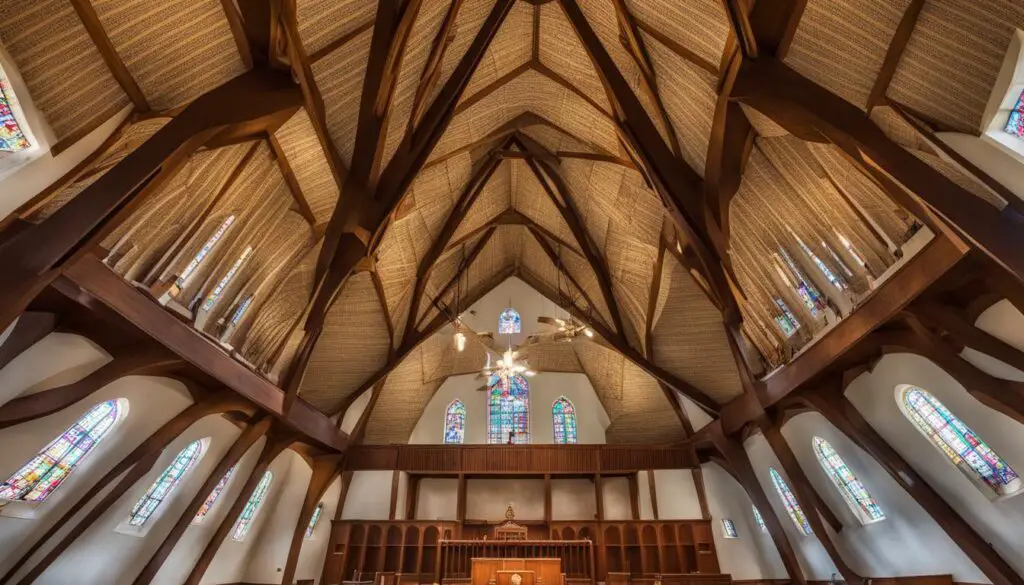
Leadership Structure
| Role | Description |
|---|---|
| Bishops | Lead the Moravian Church at the highest level, elected by the Unity Synod |
| Pastors | Provide spiritual guidance and care to local congregations |
| Congregational Members | Participate in decision-making processes and contribute to the life of the church |
“The Moravian Church values the importance of collaboration and community in decision-making processes.”
The Moravian Church’s leadership and governance structure is reflective of its commitment to inclusivity and shared responsibility. By empowering individuals to actively participate in the life of the church, the Moravian Church seeks to create a sense of ownership and belonging among its members. This participatory approach ensures that decisions are made collectively, drawing upon the wisdom and discernment of the entire community.
Overall, the leadership and governance of the Moravian Church exemplify the core values of the denomination, which include collaboration, community, and the priesthood of all believers. Through its unique system, the Moravian Church strives to foster a deep sense of connection and accountability among its members, ultimately enabling the church to fulfill its mission of spreading the message of faith and love.
Worship Practices in the Moravian Church
The Moravian Church has a rich tradition of worship practices that reflect its deep-rooted beliefs and commitment to communal spiritual experiences. One of the unique aspects of Moravian worship is the lovefeast, a ceremonial meal that emphasizes fellowship and unity among believers. During the lovefeast, participants share bread or cake and coffee or tea, symbolizing the love and togetherness they share as a community. This practice not only nourishes the body but also feeds the soul, fostering a sense of connection and celebration.
In addition to the lovefeast, hymn singing holds a special place in Moravian worship. The church has a rich heritage of hymn composition and singing, with a wide repertoire of hymns that express faith, devotion, and praise. The hymns, often accompanied by musical instruments, create a vibrant and uplifting atmosphere, inviting worshippers to engage their hearts and voices in joyful worship.
The lovefeast in the Moravian Church is a beautiful tradition that brings people together in an atmosphere of love and fellowship. It is a reminder of the love and sacrifice of Jesus Christ and the unity we share as believers. The hymns sung during worship uplift the soul and enhance the worship experience, inspiring worshippers to connect with God and each other.
The Lovefeast: A Celebratory Feast of Love and Unity
The lovefeast is not only a symbolic act of sharing food and drink but also a powerful expression of love and unity. It serves as a reminder of Jesus’ commandment to love one another as He has loved us. The lovefeast is not only an integral part of Moravian worship but also a beloved tradition that brings people together and strengthens the bonds of fellowship within the church.
Furthermore, the Moravian Church believes in the importance of creating a worshipful atmosphere through the use of music and liturgy. The carefully selected hymns and liturgical practices aim to inspire worshippers to connect with God on a deeper level and experience His presence in a meaningful way. Music is seen as a universal language that transcends barriers and touches the heart, allowing worshippers to express their devotion and praise to God.
The worship practices in the Moravian Church are designed to foster a sense of community, love, and connection with God. Through the lovefeast and hymn singing, worshippers are encouraged to participate actively, engage their senses, and experience the presence of God in a tangible and transformative way.
Contemporary Influence of the Moravian Church
The Moravian Church continues to have a significant influence in the contemporary world. With its strong commitment to social justice and outreach to marginalized communities, the church actively engages in community service, education, and mission work both domestically and internationally. The Moravian Church’s dedication to these causes has earned it a reputation as a champion for the oppressed and a source of hope for those in need.
One area in which the Moravian Church is making a difference is through its educational institutions. One notable example is Salem Academy and College in North Carolina, which was founded in 1772 and remains dedicated to providing a quality education rooted in Moravian values. Another prominent institution is Moravian College and Theological Seminary, which has been instrumental in training leaders for the church and equipping them to make a positive impact in their communities.
In addition to education, the Moravian Church also maintains strong ecumenical relations and actively participates in interfaith dialogue. As a member of the National and World Council of Churches, the Moravian Church collaborates with other Christian denominations to address common challenges and work towards greater unity. Through these collaborative efforts, the Moravian Church seeks to promote peace, understanding, and cooperation among people of different faiths.
| Denomination | Membership | Percentage of World Religions |
|---|---|---|
| Moravian Church | 1 million+ | 0.01% |
| Christianity | 2.3 billion+ | 31.5% |
| Islam | 1.8 billion+ | 24.1% |
| Hinduism | 1.2 billion+ | 15.6% |
| Buddhism | 535 million+ | 7.1% |
| Judaism | 15 million+ | 0.2% |
Current World Membership of the Moravian Church
The Moravian Church currently boasts a worldwide membership of over one million members. This significant membership base is spread across various regions, with the highest concentration in eastern Africa. Other major Moravian centers include the Caribbean basin, South Africa, Winston-Salem, and Bethlehem, Pennsylvania. The Moravian Church is organized into 24 provinces, each with its own unique characteristics and contributions to the overall church.
In North America, the Moravian Church has a strong presence, with congregations in 16 states, the District of Columbia, and two provinces of Canada. These congregations serve as vital centers of worship, fellowship, and community engagement. The Moravian Church in America actively participates in various social justice initiatives, educational programs, and mission work, reflecting its commitment to making a positive impact within local communities.
To ensure effective governance and decision-making, unity synods are held every seven years, where representatives from all provinces convene to discuss matters that affect the entire church. Through these synods, the Moravian Church maintains a cohesive structure and fosters collaboration among its diverse membership. The unity synods provide a platform for members to share insights, address challenges, and shape the future direction of the Moravian Church.
| Region | Membership |
|---|---|
| Eastern Africa | 450,000 |
| Caribbean Basin | 290,000 |
| South Africa | 120,000 |
| Winston-Salem | 70,000 |
| Bethlehem, Pennsylvania | 55,000 |
The Moravian Church continues to thrive globally, attracting new members and promoting its core values of faith, fellowship, and service. With its rich history, diverse membership, and commitment to social justice, the Moravian Church remains an influential force within the worldwide Christian community.
Moravian Church in America
The Moravian Church has a rich history in America, with its origins dating back to the 18th century. The first Moravian settlers arrived in the American colonies, starting with a failed mission in Georgia led by James Oglethorpe. However, the Moravians eventually found permanent settlement in Pennsylvania, where they established the communities of Bethlehem and Nazareth. These settlements served as centers for the Moravian Church and played a crucial role in its growth and development in America.
In addition to Pennsylvania, the Moravians expanded their presence to other areas, including North Carolina. In North Carolina, they founded the settlements of Bethabara, Bethania, and Salem, which later became known as Winston-Salem. These Moravian settlements played a significant role in the development of the state and became centers of religious, educational, and cultural activities.
The Moravian Church in America has experienced growth and expansion since its early days. Today, the church has congregations in 16 states, the District of Columbia, and two provinces of Canada. These congregations continue to uphold the traditions and values of the Moravian Church, serving as vibrant communities of faith and spreading the message of love, unity, and service.

Preservation of Moravian Heritage
The Moravian Church places great importance on the preservation of its rich heritage and history. One significant effort in this regard is Historic Bethabara Park in Winston-Salem, North Carolina. This park serves as both a museum and an educational center dedicated to preserving the Moravian past and making it accessible to future generations.
Historic Bethabara Park offers a unique glimpse into the daily life, culture, and history of the Moravian settlers in America. Through its exhibits and programs, visitors can explore the early years of the Moravian Church in America and gain insights into the challenges and triumphs experienced by the community.
The park features authentically restored buildings, including a reconstructed village and a 1753 church. These structures provide a tangible link to the past and allow visitors to step back in time. Walking through the park, visitors can experience the sights, sounds, and atmosphere of the Moravian settlement, gaining a deeper understanding of the Moravian Church’s role in shaping American history.
| Historic Bethabara Park Highlights | Experience |
|---|---|
| Authentic restorations | Step into the past and explore recreated buildings that offer a glimpse into the lives of Moravian settlers. |
| Interactive exhibits | Engage with dynamic exhibits that bring the history and culture of the Moravian Church to life. |
| Guided tours | Join knowledgeable guides who share fascinating stories and provide in-depth insights into the Moravian heritage. |
| Educational programs | Participate in workshops and educational activities designed to deepen your understanding of Moravian history and culture. |
“Historic Bethabara Park is a true treasure for those seeking to learn about and appreciate the Moravian heritage. Its commitment to preserving and sharing this rich history ensures that the legacy of the Moravian Church will endure for generations to come.” – Visitor testimonial
Through initiatives like Historic Bethabara Park, the Moravian Church continues to support and maintain its heritage, ensuring that the stories and contributions of the Moravian pioneers are celebrated and shared. By preserving its past, the Moravian Church honors its traditions while inspiring present and future generations to carry forward its legacy of faith, community, and love.
Conclusion
The history of the Moravian Church is rich and enduring, rooted in ancient Bohemia and Moravia. As one of the oldest Protestant denominations in the world, it has withstood persecution, schisms, and challenges over the centuries, demonstrating its resilience and unwavering faith.
The Moravian Church’s beliefs and doctrines center around the teachings of Jesus Christ, emphasizing unity, love for enemies, and living a life guided by His example. These core principles have shaped the church’s worship practices, emphasizing communal worship, lovefeasts, and hymn singing.
The Moravian Church’s historical significance is marked by its pioneering efforts in missions, education, and cultural development. Despite being a relatively small denomination, the Moravians have left an indelible impact on the global Christian community.
In its growth and expansion, the Moravian Church has experienced denominational splits and schisms, reflecting both internal challenges and external circumstances. However, it has also demonstrated its ability to adapt and forge new paths, such as the establishment of the Renewed Unitas Fratrum.
Today, the Moravian Church continues to influence society through its commitment to social justice, community service, and mission work. With over one million members worldwide, the Moravian Church remains a significant Christian denomination, actively engaging in ecumenical relations and maintaining strong ties to its historic roots.
FAQ
What is the history of the Moravian Church?
The Moravian Church, also known as the Unity of Brethren, originated in ancient Bohemia and Moravia in what is now the Czech Republic. It was officially organized in 1457 and is one of the oldest Protestant denominations in the world.
Who were the founders of the Moravian Church?
The Moravian Church can trace its origins back to Greek Orthodox missionaries Cyril and Methodius, who translated the Bible into the common language and introduced a national church ritual. It was further shaped by the Czech reformer John Hus.
What are the key beliefs of the Moravian Church?
The Moravian Church believes in living a life guided by the teachings of Jesus Christ, prioritizing values such as gentleness, humility, patience, and love for their enemies. They emphasize unity among believers and the importance of following Jesus’ example in words and actions.
What is the historical significance of the Moravian Church?
Despite its relatively small size, the Moravian Church has had a significant impact throughout history. It has played a visible role in the global Christian community, being the first Protestant denomination to send missionaries and contributing to the development of education and culture in the areas where it was established.
Has the Moravian Church experienced schisms or denominational splits?
Yes, the Moravian Church has experienced schisms and denominational splits, including during the Thirty Years War in the 1600s and during the reign of Count Nicholas Ludwig von Zinzendorf in the 18th century. These splits led to the establishment of various factions within the Moravian Church.
How is the Moravian Church led and governed?
The Moravian Church is led by bishops who are elected by the Unity Synod, a governing body that meets every seven years. The bishops oversee the spiritual and administrative affairs of the church, while each local congregation is led by a pastor responsible for the members’ spiritual guidance and care.
What are the worship practices of the Moravian Church?
The Moravian Church places a strong emphasis on communal worship and fellowship. One unique aspect of their worship is the lovefeast, a ceremonial meal that includes the sharing of bread or cake and coffee or tea. Hymn singing is also an integral part of Moravian worship.
What is the contemporary influence of the Moravian Church?
The Moravian Church is actively involved in community service, education, and mission work, both domestically and internationally. They are known for their commitment to social justice and outreach to marginalized communities, as well as their strong ecumenical relations.
How many members does the Moravian Church have worldwide?
The Moravian Church currently boasts a worldwide membership of over one million members. The majority reside in eastern Africa, with other significant centers in the Caribbean basin, South Africa, Winston-Salem, and Bethlehem, Pennsylvania.
What is the history of the Moravian Church in America?
The first Moravian settlers arrived in the American colonies in the 18th century, with permanent settlements established in Pennsylvania, including Bethlehem and Nazareth. The Moravian Church later expanded to other areas, including North Carolina, where they founded the settlements of Bethabara, Bethania, and Salem (now Winston-Salem).
How is the Moravian heritage preserved?
The Moravian Church places importance on preserving its heritage, and Historic Bethabara Park in Winston-Salem, North Carolina, serves as a museum and educational center dedicated to preserving the Moravian past. The park’s exhibits and programs provide insights into the daily life, culture, and history of the Moravian settlers in America.


